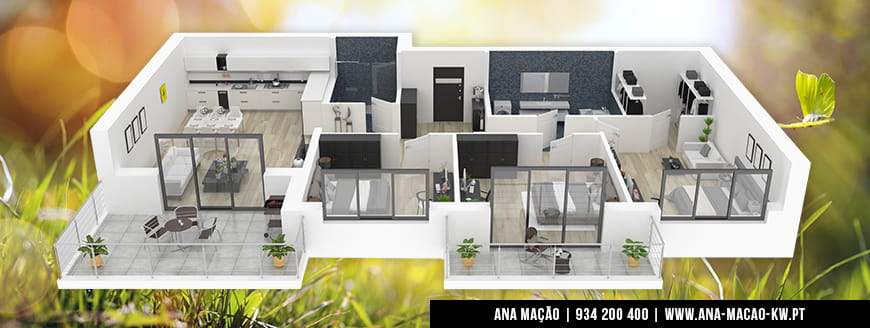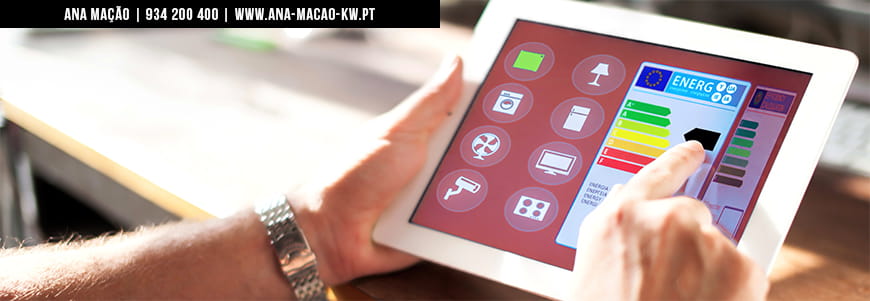Sun exposure
This question is essential, both for those who want to build a new house, and for those who want to buy a used house. Despite its importance, it is an issue that is usually undervalued. Many buyers are enchanted by other aspects of the home and only too late realize that they have made a mistake, which will have consequences for the habitability and quality of life, as well as the future profitability of their investment.
If you are going to build a new house, where should you direct it?
The ideal scenario occurs when the most used rooms in the house are oriented so as to capture the maximum hours of sun exposure (in regions of Portugal with a cold to moderate climate), with a view to improving energy efficiency and maximizing natural lighting . That is, when the house faces south, with slight deviations to the east or west .
The most used divisions are understood to be: social divisions , which include bedrooms, living rooms, office, terraces/balconies, swimming pool , etc.
The least used divisions will be the entrance hall and other circulation areas , garage , pantry , storage areas , etc.
However, this solar orientation is not always the most appropriate, as it depends on:
- Climate of the region;
- Level of thermal insulation of the dwelling (walls and roofs);
- Thermal performance of windows and window frames (namely in second-hand homes).
Thus, depending on these 3 variables, the suggested solar orientation will or will not be the most appropriate.If the climate is temperate throughout the year (more coastal areas and the south of Portugal) and your house has good thermal insulation, then you will have more degrees of freedom to manage this choice, not least because there are other guidelines that are also appealing, depending on your personal taste:
Orientation to the East
 It may be inadvisable to place the rooms facing the sunrise, as most people prefer to choose the time to wake up, but there are those who like to be woken up by its rays. The rising light is a soft, gentle light that warms up your start of the day and helps you wake up and gain the necessary rhythm for the rest of the day. There are those who enjoy the company of the first rays of sunlight during their morning meal and the absence of direct light the rest of the day, emphasizing the colors and decoration of the social areas.The direct sun "burns" the colors and damages the visual composition of your decor. Of course, you can use curtains or blinds that help to filter out excess light, but it will also be jeopardizing the views to the outside.
It may be inadvisable to place the rooms facing the sunrise, as most people prefer to choose the time to wake up, but there are those who like to be woken up by its rays. The rising light is a soft, gentle light that warms up your start of the day and helps you wake up and gain the necessary rhythm for the rest of the day. There are those who enjoy the company of the first rays of sunlight during their morning meal and the absence of direct light the rest of the day, emphasizing the colors and decoration of the social areas.The direct sun "burns" the colors and damages the visual composition of your decor. Of course, you can use curtains or blinds that help to filter out excess light, but it will also be jeopardizing the views to the outside.
south facing
 This is the orientation with the highest degree of luminosity, the strong light is a magnet for people who seek to be surrounded by peace, in pure and orderly environments. Recommended for areas of the country where the climate is cold and humid or where the topography of the land makes the days shorter. The strong and clear light invites the color contrast of the decoration. You can risk using a bolder color palette.
This is the orientation with the highest degree of luminosity, the strong light is a magnet for people who seek to be surrounded by peace, in pure and orderly environments. Recommended for areas of the country where the climate is cold and humid or where the topography of the land makes the days shorter. The strong and clear light invites the color contrast of the decoration. You can risk using a bolder color palette.
West Orientation
 - On the other hand, there are those who like to work or enjoy the exposure to the west at home and let the sun's rays at the end of the day invade their space, with its warm tones. In this case, the use of warm colors in the decoration is not recommended. The Sun takes care of "warming up your decor" with its golden and orange tones.
- On the other hand, there are those who like to work or enjoy the exposure to the west at home and let the sun's rays at the end of the day invade their space, with its warm tones. In this case, the use of warm colors in the decoration is not recommended. The Sun takes care of "warming up your decor" with its golden and orange tones.
North Orientation
 - If what you like is soft light throughout the day, this is the ideal exposure. It will receive some rays of sunlight at the beginning and end of the day, but for the rest of the time it is daylight that takes care of the lighting. The north-facing houses provide consistent lighting throughout the day, without great contrasts but offering a calm and peaceful atmosphere. The house should have good thermal insulation, or the climate should be mild in winter and hot in summer. You can compensate for the lower luminosity, using large glass areas, or skylights. Whitening the walls or using floors in a light tone is a good option for decoration.
- If what you like is soft light throughout the day, this is the ideal exposure. It will receive some rays of sunlight at the beginning and end of the day, but for the rest of the time it is daylight that takes care of the lighting. The north-facing houses provide consistent lighting throughout the day, without great contrasts but offering a calm and peaceful atmosphere. The house should have good thermal insulation, or the climate should be mild in winter and hot in summer. You can compensate for the lower luminosity, using large glass areas, or skylights. Whitening the walls or using floors in a light tone is a good option for decoration.
Northeast (North / East), Southeast (South / East), Southwest (South / West) and Northwest (North / West) - These are variants of the exposures mentioned above and that allow balancing the mentioned effects, attenuating or accentuating their impact .
Climate and sun exposure in Portugal
Portugal is characterized by benefiting from a temperate climate with mild temperatures, being influenced by its maritime exposure to the Atlantic and Mediterranean, which contribute to hot summers and wet winters . But, despite its territory not being very large, the climate and temperatures vary according to latitude, altitude and proximity to the sea:
- Influence of latitude: the South is warmer than the North;
- Influence of the sea: the coast is not so cold in winter, nor so hot in summer;
- Influence of relief: the more mountainous areas of the North and Center are colder;
- Influences from the enclosed valleys: namely in the Douro, where summers are very hot.
It is therefore important to take into account the specificities of each region, as its format and topography mean that between the North and the South, the coast and the interior, the degree of humidity and the thermal differences are great.
- Further north, in Minho (Viana do Castelo, Braga...), the climate is colder and wetter in winter.
- In the interior north of the country - Trás-os-Montes (Vila Real, Bragança...) , Alto Douro (Viseu...) and Beiras (Guarda, Castelo Branco, Covilhã...) - as they are more mountainous regions, the climate in general is colder and more humid , with the possibility of periods of snow in the higher areas . In these regions, it is preferable that the solar orientation is facing south , in order to benefit from the greatest number of hours of sun exposure.
- In Lisbon, Alentejo (Portalegre, Évora, Beja...) and Algarve (Portimão, Faro...) the summers are longer and hotter with maximum temperatures around 35, 40°C. Humidity decreases as we move away from the sea coast, and in the interior areas, in Alentejo, temperatures are very high in summer, especially in Beja.Therefore, in this region, the most used rooms in the house should be avoided facing south, with East-West solar orientation being a suitable option.
- Madeira benefits from a year-round subtropical climate, with mild and stable temperatures, while in the Azores winter is generally windier and wetter.
The influence of solar orientation on a house

The areas of the house facing each of the quadrants have specific particularities that it is important to know, insofar as sun exposure conditions comfort and the respective energy consumption:
- North: face of the house with reduced sun exposure, colder and damp in winter, contributing to rooms with this exposure being very cold in winter and cool in summer. Depending on the house being located in a region further north of the country, one may choose to reduce the number of windows, mitigating thermal losses ;
- East (East): some sun exposure, especially during the morning when the sun is low. Very cool place in winter but quite pleasant in summer;
- South: the best side of the house, provides good sun exposure throughout the year, benefits from low sun in winter. Para minimizar o sobreaquecimento das divisões, especialmente na região Sul de Portugal, é conveniente utilizar proteções solares do tipo: palas, alpendres, proteção de alçados, telheiros ou outros “obstáculos” de origem natural (árvores de folha caduca, etc.). Desta forma a casa continua iluminada e aquecida durante o Inverno, quando o Sol anda mais baixo, mas desempenha uma proteção importante no Verão, quando o Sol circula numa posição mais alta;
- Poente (Oeste): as divisões orientadas a poente, beneficiam de forte exposição solar nos períodos da tarde, com sobre iluminação nas horas de poente ou quando o sol se encontra em posição mais baixa, como no Inverno. Localização ideal para plantar árvores.
Sugestões para a orientação das divisões de uma casa

Despite what was said in relation to the specificities of each region of Portugal, here are some suggestions for a better orientation of the different rooms of a house:
- North - As this is the coldest area with the least exposure to the sun in the house, it is recommended for the location of the garage , pantry , laundry , outbuildings and storage areas;
- East - With morning sun exposure, it is ideal for areas that, despite being cooler in winter, are quite comfortable in summer, such as: workshops and atelier , gym , solarium , entrance hall , cloakroom , kitchen/pantry , guest room , bathroom, etc.;
- South - This is the area of the house with the most light and exposure to the sun, which is why it is ideal for areas of enjoyment and leisure: swimming pool , bedrooms , dining room , terraces and balconies , entrance hall ;
- West - Facing the sunset, it is recommended for rooms that need good lighting . In warmer regions, or during the summer, there will be an increase in temperature that can be compensated with cooling systems (air conditioning, forced ventilation, etc.), and will be the ideal area of the house for rooms such as rooms, social areas , office , library , corridors , stairs and circulation areas , balconies and terraces ;
Advantages and disadvantages associated with sun exposure of a house
This is one of the most important factors to consider when buying a house or preparing an architectural project, if you intend to build a new one. Some of the benefits associated with the correct sun exposure of a house are:
Improvement of energy consumption - Depending on the climate of the region where the house is located, it will be convenient to orient the rooms in order to protect those that are used most, from excess heat or cold. In this way, you will use less artificial heating/cooling methods, saving energy consumption and reducing gas or electricity bills in the seasons with the highest peak temperatures.
Energy Efficiency Certificate - This is a factor that weighs positively or negatively in the valuation of a house. Thus, a good efficiency index declared in the Energy Certificate (which takes into account the sun exposure of the property), can help to sell your home more easily and for a higher price.
Comfort and health - Living in a house facing north, especially in areas close to forests or mountains, will contribute to making the house more humid, with the consequent problems that this can cause in terms of the health of children and older adults;
Valuing a house - Those who buy a house do not always think that one day they may have to sell it, but when that happens, they may face increased difficulties. Potential buyers will reject properties with poor sun exposure, with the owner having to lower the sale price in order to close the deal.
What to do to lessen the effects of bad sun exposure?

Sometimes it is not possible to do anything about the solar orientation of a house, either because the orientation of the land or the location polygon do not allow it, or simply because the house or apartment you bought was built by a third party. But here are some tips to lessen the negative impact of poor solar orientation:
- Choose the most suitable divisions to serve as a bedroom, living room or office, depending on the occupation time and the need for more or less sun exposure, more or less heat;
- Window frames and window glass are one of the most important sources of heat and cold transfer. Replacing the windows with windows with better thermal insulation is a solution (eg Tilt-turn windows with double glazing and thermal break, allow a reduction of thermal transmission between 40% and 60%). However, you should not fail to safeguard the issue of ventilation in order to allow air renewal.
- If the house gets too hot, install suitable blinds / curtains in order to filter out the sun, especially when it hits in the morning or at dusk. Alternatively, you can apply Solar Protection Films over existing glass. These films insulate in winter and summer, filter solar radiation (infrared rejection up to 98%), allowing a reduction in air conditioning costs and an almost total absorption of ultraviolet rays.
- If it is a house with a garden and has too much sun exposure, plant deciduous trees in order to create a natural curtain to reduce sunlight in the summer, safeguarding the winter period, when the leaves fall and more solar radiation is needed .
- If you have walls with strong exposure to the sun or these do not have the appropriate thickness / thermal insulation, you can request the intervention of a company specialized in Exterior Thermal Insulation (using, for example, coating with acrylic). The application of this thermal insulation reduces humidity due to condensation (mold) and contributes to improving the energy efficiency of the house.
- If your home is cold and has a fireplace, consider installing a heat recovery system to take advantage of the heat from the fireplace and heat the coldest rooms during the winter.
Important Note: The information in this glossary is for informational purposes only. For proper advice on legal or tax matters, consultation with a duly authorized lawyer, notary, solicitor, or accountant is essential.
Your next step in the real estate market
Whether you want to sell your property for the maximum value or find the ideal home, count on my experience as a Top Producer consultant at KW Portugal. Talk to me without obligation. Start today with a simple contact.
Contact Me Today
Related articles






